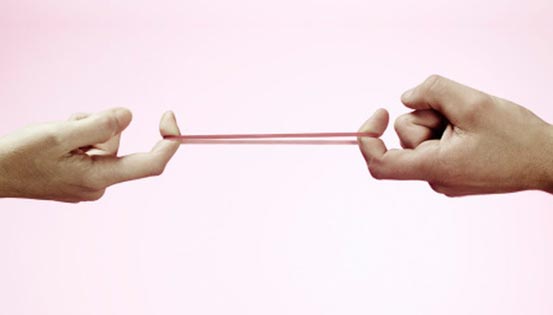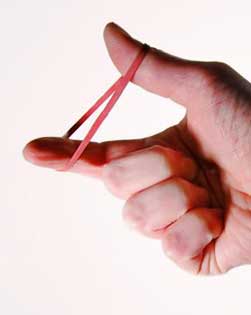Rubber is one of the most curious natural materials of all. Its natural elasticity has been a subject of discussion since time immemorial. The logic behind the property of elasticity of rubber or rubber goods is that in a relaxed state, the rubber is attributed with a long, rolled up polymer chains which are interlinked at a couple of points. Now between each pair of links, every single monomer can rotate freely around its neighbor, thus making a way for each section of chain to amass a number of geometries similar to a loose rope attached to fixed points from either ends. At room temperature, rubber holds enough kinetic energy for each section of chain to move frantically, just the way a rope is being shaken violently.


Mr. Werner Kuhn was the one who developed the entropy model of rubber in
1934. During a stretched position, the loose pieces of rope become
relatively stiff and thus are not able to oscillate much. Since its kinetic
energy is lost as excess heat, the entropy decreases while transiting from
relaxed to stretched mode and vice-versa. The change in entropy can be
understood by the fact that a relaxed piece of rubber can be folded in many
ways as compared to a stretched section of rubber.
Thus, relaxation of a stretched rubber band
is actually based on the increased entropy and the transition of thermal
energy into kinetic energy. As it is rubber relaxation is an endothermic
state, this is precisely the reason why the force exerted by a stretched
piece rubber increases with temperature. While during contraction the
material experiences adiabatic cooling. This can be tested by stretching a
piece of rubber band against your lip and feel the coolness of it.
- Anti Vibration Mountings
- Automobile Rubber Products
- Calendered Rubber Products
- Extruded Rubber Products
- Medical Rubber Products
- Metal Bonded Components
- Rubber Adhesives & Sealants
- Rubber Ball
- Rubber Bands
- Rubber Beading
- Rubber Bearing
- Rubber Belt
- Rubber Buckets
- Rubber Bullets
- Rubber Cable
- Rubber Coating
- Rubber Duct
- Rubber Expansion Joints
- Rubber Flooring/Matting
- Rubber Footwear
- Rubber Gloves
- Rubber Injection Parts
- Rubber Lining
- Rubber Magnets
- Rubber Molded Products
- Rubber Pads
- Rubber Rollers
- Rubber Stopper
- Rubber Suit
- Rubber Track
- Rubber Valve
- Rubber Balloon
- Rubber Stamps
- Rubber Fenders
- Acrylic Rubber (ACM)
- Butadiene Rubber (BR)
- Butyl Rubber (IIR)
- Chlorosulfonated Polyethylene(CSM)/ Hypalon
- Ethylene Propylene Diene Monomer
- Fluoroelastomers (FKM)/Viton
- Isoprene Rubber (IR)
- Nitrile Rubber (NBR)
- Perfluoroelastomer (FFKM)
- Polychloroprene (CR)/Neoprene
- Polysulfide Rubber (PSR)
- Silicone Rubber (SiR)
- Styrene Butadiene Rubber
How to Make a Custom Rubber Stamp?
Whenever designing a custom stamp for your company, never compromise on its quality because in the end it is the most...
Read MoreLatex and Silicone Rubber Tubing - A Comparison!
Many industries use rubber tubing for various purposes. In fact, various types of rubber tubing are used for different applications...
Read MoreSilicone vs Acrylic Adhesive- A Comparison
Silicon and acrylic adhesives are those rubber adhesives that are widely used in Polyimide tapes. In fact, the polyimide...
Read More

